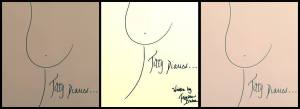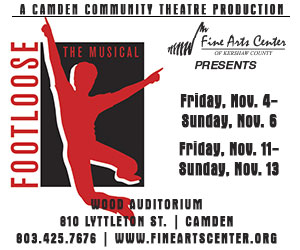“It’s not the sexy that’s the problem: it’s the sexism.”
— Ed Madden
Let me start by saying I really wanted to like the play Titty Diaries, written by Trinessa Dubas and directed by Caletta Harris-Bailey, staged at CMFA October 23-25. It has all the right bona fides. It was staged in partnership with and as a fundraiser for Dianne’s Call, a local health non-profit targeting underserved communities (http://diannescall.org/). It’s by a new playwright—and I want to raise up the city’s up-and-coming writers. With its title and episodic monologue structure, the play is also clearly intended to echo The Vagina Monologues by Eve Ensler, a play I have taught, a play staged annually in Columbia as a fundraiser for domestic violence and rape crisis services. Staged during Breast Cancer Awareness Month, Titty Diaries is supposed to address breast cancer awareness and body image. And it was clear that the audience seeing the play Saturday evening enjoyed the performance, not just its broad and usually stereotypical humor, but its emotional pathos as well.
So many reasons to want to like this play, and yet I left the theatre deeply troubled, in part because the play seemed more endorsement than indictment of a sexist culture that objectifies women. I also left convinced that the play is not quite ready for the stage—despite the playwright and director’s announced intentions to extend it to a full-length production and take it on the road—mostly because it’s not quite clear yet what the playwright wants this play to do and be.
Gender, or Yes but Why Bother
The first and fundamental problem is the play’s awkward engagement with gender issues. Like a lot of mainstream culture, from country music to community theatre melodrama to Real Housewives of Whatever, it seems to be about female empowerment, but only within the constraints of traditional gender roles, and only if we refuse to question the pervasive cultural sexism they reenact. Despite a script filled with female roles and stories, options for women here are limited.
The first scene, “My Eyes Are Up Here,” established my unease. In it, Terra, a single woman in a bar says she uses her cleavage to get free drinks. She gets annoyed when a man ogles her breasts and tells him, “My eyes are up here,” but that little moment of feminist snap is framed within a scene that’s all about using your anatomy to get things.
As Terra puts it: “As a single woman, I get a good thrill off of simple mined men. It’s not me, but do I ask for this? Am I inviting unwanted niceties when I decide on the cut of a shirt? Or can the blame be put on a man who may quite possibly have been breast-fed and can‘t get past a titty without salivating? Can I truly expect him to concentrate on what I am saying as opposed to what he sees, when my titties are so very prominent in this V? The answer is yes, and why bother? […] the purpose when flying solo in the Queen City is to get them dranks.”
Yes, she suggests, I should expect a man to listen to me, whatever I’m wearing, but why bother—men being men, the culture being the culture. It’s not about empowering sexual expression: it’s about using your body to get what you want. This becomes overt three scenes later in “Cause I Get What I Want,” the story of Fatima, a golddigger with a couple of pro athlete boyfriends. Like Terra, she doesn’t want to feel guilty about her own self-objectification: “I have to say this; it really is not my fault. […] Because of these babies (little chest jiggle to show breasts) I get what I want.” As if to chide audience members like me, she adds, “Now don’t knock me for being sexy. It’s a fact that I had to accept.”
It’s not the sexy that’s the problem: it’s the sexism.
I know there’s a fine line here. On the one hand, the play wants to insist, à la Eve Ensler, that women’s sexual expression can be about women’s sexual and self empowerment. On the other, we live in a culture that objectifies women and hypersexualizes black women. (Google it.) So when Fatima tells us “a girl needs sponsors,” the line between female sexual empowerment and self-objectification is erased. Of course, these are only two of 11 scenes, but we really don’t get any corrective or counter voices. We get an aging exotic dancer wondering if she can go back onstage because her breasts are no longer perky. We get two older women telling a young wife to “titty-fuck” her husband when she’s menstruating because her job is to make her man happy. That she doesn’t understand that the “string of pearls” she will receive is a euphemism only reinforces the play’s emphasis on using your body to get what you want.
Representation, or Nothing Like a Real Woman
The second problem, as suggested by Fatima the golddigger, is the use of stereotype. The play offers a project of inclusivity, including multiple generations, even the stories of a man who suffers from gynecomastia (enlarged male breasts) and a transgender character. But it’s one thing to traffic in stereotypes for humor’s sake and another to reduce human stories to caricature, especially given the play’s seeming vision of inclusion.
The trans character (or caricature), Chortnii, announces, “Today transsexuals, transgender and transvestites are all over the place. We celebrate ferociously, but ain’t nothing like a real woman, with real titties.” Really? Despite RuPaul’s Drag Race, out in the real world trans people suffer violence and discrimination. And how offensive is it to put the play’s most anti-transgender line (“ain’t nothing like a real woman,” emphasis on real) in the mouth of a trans character? As if to make this character a grab-bag of sexual otherness as well as an anti-transgender caricature, the play adds fetishism and sexual orientation to the mix. Born “a boy who likes boys,” Chortnii morphs into sexual fetishist—“my fetish, men with titties”—and she dismisses a friend as “an old lesbian hag.” Given the fact that studies have found that lesbians and bisexual women have higher rates of breast cancer than heterosexual women, this joke only deepens the offense of the most offensive scene in the play.
Thinking about representation and inclusivity, two other issues seem striking. The inclusion of the male character, Frank, highlights the often ignored issue of male breast cancer, as well as the issue of bullying, but it also is the only narrative that addresses sexual abuse. “I was molested as a teen,” he says, his breasts groped by an old man. In a play full of women’s voices, it seems at the very least awkward that his is the only story of sexual abuse. Just as the trans character is forced to bear the burden of all sexual otherness, the issue of sexual abuse is displaced onto the only male character in the play. Thinking about representation and women’s experience, I also thought it odd that in a play about breasts, there are no references to nursing—a positive and familial image of nurture and generational connection—other than Terra’s suggestion that men fetishize breasts because they suckled too long.
Intent and the Human Story
Finally, despite the pre-performance publicity, it simply wasn’t clear what this play is meant to do and be. The “dear diary” voiceovers that precede each monologue suggest a kind of intimacy, an entrée into private stories we don’t usually hear. But the voiceovers themselves either emphasized the characters as types, or, confusingly, as real people, in an I-knew-someone-just-like-that way. Further, both the script and the program insist the play is “ethnic/gender neutral,” but I wondered if, in fact, it might be a more interesting play if it were more explicitly about African American culture. That is, rather than disavowing the ethnic element, as the playwright does, would an examination of the specificities of cultural experience actually strengthen the play.
The question of intent is primarily located in the script, but I wonder if the staging amplified this issue. Whether to make the point that these stories are all connected, or because of the exigencies of CMFA lighting, or both, the director put all the cast on stage, lights up on all, a bit of furniture here and there marking off each individual performance space. As a monologue was performed, the lights went down and that character left the stage, a slow emptying that at least helped us focus our attention as the lights came up again.
While this might have the effect of suggesting that these stories were part of the same story, the cluttered stage also left a couple of pieces unfocused—almost literally because you couldn’t see what was going on. The shortest scene, “Self Esteem,” for example, was pushed far back stage left. As the only scene without the “dear diary” voiceover, and the only piece centered on symbolic action rather than language, the piece had more felt emotional weight than others. No monologue, just a woman sitting at a mirror, wrapped in a robe. But from where I was sitting, I couldn’t really tell what she was doing. Sliding inserts in her bra? The script says, “lights on Veronique as she picks up a silicon breast and places it in one bra and then the other.” Was this scene about plastic surgery—as someone sitting behind me suggested? (The script calls for a slide show of images, including a teenage girl stuffing her bra.) Or was it about mastectomy? (The scene is preceded by an old woman who refuses to get a breast reduction, despite her debilitating back pain—refuses the surgery despite medical need.) Given the extraordinary importance of the stage action, this scene should have been performed downstage. The actor then picks up the phone to make an appointment with a doctor. Lights down, and we move quickly and jarringly to the exotic dancer sitting prominently front stage left.
The play’s final scene was moving, in part because the voiceover and pre-performance publicity insists it’s based on a real story. But even then there was a kind of awkwardness to the scene, as the woman diagnosed with breast cancer slipped out of character to deliver some educationese about statistics (perhaps more appropriate for the program than performance). Indeed, despite the emotional power of the story, the whole scene moved erratically through kinds of speech, the effect of which was a kind of discursive whiplash, as the primary character moves quickly in and out of dialogue, impassioned prayer addressed to God, monologue addressed to the audience, health education discourse, to a final bit of unbelievable sloganeering—“If you or someone you love are having a difficult time dealing with a diagnosis just know that you have to keep fighting forward. Support research. We’ve come so far in healing and care. With early detection the battle is that much easier to win. Don’t give up.” This mishmash of languages—educational, devotional, performative, political—suggests, perhaps, the play’s unclear impulses.
As if to emphasize the human story at the heart of this project, after the play ended, the stage manager asked cancer survivors to raise their hands, asked anyone diagnosed to raise their hands, a moment that felt heartbreakingly awkward and wrong.
~~~~
The day after, I went to see The Brothers Size at Trustus. One play troubled me, the other crushed me. One set cluttered with furniture, the other evoking bayou, carshop, and home with ritualized action and the simplest of props. One script depending on a junkshop of stereotypes to tell a deeply human story, the other developing a deeply human story out of myth and type. Unfair, I know, to compare community theatre to professional, a new unfinished play to an award-winning play, unfair to juxtapose these aesthetics. But something about that juxtaposition clarified for me the importance of getting the human story right, emphasized for me the potential of theatre to create empathy and understanding. Clarified for me why I wanted Dubas’s play to do something more.
We like to say that Columbia is a writers’ town, but I wonder if that’s true across all kinds of writing? Is it a town for playwrights? Do we have workshops for playwriting—workshops that would offer aesthetic and political critique, blocking suggestions, proofreading, as well as friendly support? I don’t know. I know that I love to see vibrant and scrappy and interesting theatre and performance culture developing outside and beyond the main stages. I know that a lot of what I say here would probably come up in a workshop critique or a staged reading with feedback. I know that Jasper is working on a playwright’s workshop.
I also know that I would love to see more work by Dubas. There’s an energy and cultural importance to this play, an ambition and riskiness, despite its problems. In a culture in which breasts are insistently eroticized, in which cosmetic surgery is becoming common, in which pop stars sport beach-ball-sized bosoms, and in which breast cancer is so oddly part of mainstream thinking that a local bakery slathers pink icing on everything, we need a play that makes us stop and think about what our culture tells us about breasts. This isn’t yet that play. Yet.
Ed Madden is the literary arts editor for Jasper Magazine and the director of Women’s and Gender Studies at USC.







.jpg)